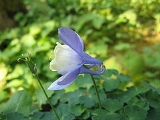
Aquilegia
Encyclopedia
Aquilegia is a genus
of about 60-70 species
of perennial plant
s that are found in meadow
s, woodland
s, and at higher altitudes throughout the Northern Hemisphere
, known for the spurred petals of their flower
s.
"Columbine" is derived from the Latin word for pigeon (columba).
(baneberries) and Aconitum
(wolfsbanes/monkshoods), which like Aquilegia produce cardiogenic toxin
s.
(butterflies and moths) caterpillar
s. These are mainly of noctuid moths – noted for feeding on many poisonous plants without harm – like Cabbage Moth
(Mamestra brassicae), Dot Moth
(Melanchra persicariae) and Mouse Moth
(Amphipyra tragopoginis). The Engrailed
(Ectropis crepuscularia), a geometer moth
, also uses columbine as larval foodplant.
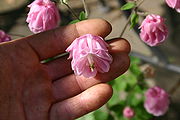 Several species are grown in gardens, including the European Columbine (A. vulgaris), a traditional garden flower in many parts of the world. Numerous cultivar
Several species are grown in gardens, including the European Columbine (A. vulgaris), a traditional garden flower in many parts of the world. Numerous cultivar
s and hybrids have also been developed as well. They are easy to propagate from seed.
Columbine is a perennial, which propagates by seed. It will grow to a height of 15 to 20 inches. It will grow in full sun, however, prefers growing in partial shade and well drained soil, and is able to tolerate average soils and dry soil conditions. Columbine is rated hardiness of Zone 3 so does not require mulching or protection in the winter.
Large numbers of hybrids are now available for the garden, since the British A vulgaris was joined by other European and N American varieties.
Aquilegia species are very interfertile, and will self sow.
s as a condiment
with other fresh greens, and are reported to be very sweet, and safe if consumed in small quantities. The plant's seeds and roots are highly poisonous however, and contain cardiogenic toxin
s which cause both severe gastroenteritis
and heart palpitations if consumed as food. Native Americans used very small amounts of Aquilegia root as an effective treatment for ulcer
s. However, the medical use of this plant is better avoided due to its high toxicity; columbine poisonings may be fatal.
(see also Columbine, Colorado
).
. It was found that Sierra Columbine (A. pubescens) and Crimson Columbine
(A. formosa) each have specifically adapted
pollinator
s, with hawkmoths that can pollinate one species while usually failing to pollinate the other. Such a "pollination syndrome
", being due to flower genetics
, ensures reproductive isolation
and can be a cause of underlying speciation
.
_02.jpg)

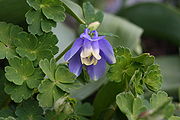
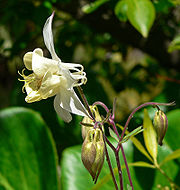

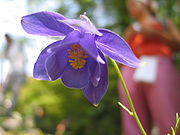 Columbine species include:
Columbine species include:
Genus
In biology, a genus is a low-level taxonomic rank used in the biological classification of living and fossil organisms, which is an example of definition by genus and differentia...
of about 60-70 species
Species
In biology, a species is one of the basic units of biological classification and a taxonomic rank. A species is often defined as a group of organisms capable of interbreeding and producing fertile offspring. While in many cases this definition is adequate, more precise or differing measures are...
of perennial plant
Perennial plant
A perennial plant or simply perennial is a plant that lives for more than two years. The term is often used to differentiate a plant from shorter lived annuals and biennials. The term is sometimes misused by commercial gardeners or horticulturalists to describe only herbaceous perennials...
s that are found in meadow
Meadow
A meadow is a field vegetated primarily by grass and other non-woody plants . The term is from Old English mædwe. In agriculture a meadow is grassland which is not grazed by domestic livestock but rather allowed to grow unchecked in order to make hay...
s, woodland
Woodland
Ecologically, a woodland is a low-density forest forming open habitats with plenty of sunlight and limited shade. Woodlands may support an understory of shrubs and herbaceous plants including grasses. Woodland may form a transition to shrubland under drier conditions or during early stages of...
s, and at higher altitudes throughout the Northern Hemisphere
Northern Hemisphere
The Northern Hemisphere is the half of a planet that is north of its equator—the word hemisphere literally means “half sphere”. It is also that half of the celestial sphere north of the celestial equator...
, known for the spurred petals of their flower
Flower
A flower, sometimes known as a bloom or blossom, is the reproductive structure found in flowering plants . The biological function of a flower is to effect reproduction, usually by providing a mechanism for the union of sperm with eggs...
s.
Etymology
The genus name Aquilegia is derived from the Latin word for eagle (aquila), because the shape of the flower petals are said to resemble an eagle's claw."Columbine" is derived from the Latin word for pigeon (columba).
Relatives
Columbines are closely related to plants in the genera ActaeaActaea
Actaea, commonly called baneberry or bugbane, is a genus of flowering plants belonging to the family Ranunculaceae, native to temperate regions of the Northern Hemisphere....
(baneberries) and Aconitum
Aconitum
Aconitum , known as aconite, monkshood, wolfsbane, leopard's bane, women's bane, Devil's helmet or blue rocket, is a genus of over 250 species of flowering plants belonging to the buttercup family .-Overview:These herbaceous perennial plants are chiefly natives of the mountainous parts of the...
(wolfsbanes/monkshoods), which like Aquilegia produce cardiogenic toxin
Toxin
A toxin is a poisonous substance produced within living cells or organisms; man-made substances created by artificial processes are thus excluded...
s.
Insects
They are used as food plants by some LepidopteraLepidoptera
Lepidoptera is a large order of insects that includes moths and butterflies . It is one of the most widespread and widely recognizable insect orders in the world, encompassing moths and the three superfamilies of butterflies, skipper butterflies, and moth-butterflies...
(butterflies and moths) caterpillar
Caterpillar
Caterpillars are the larval form of members of the order Lepidoptera . They are mostly herbivorous in food habit, although some species are insectivorous. Caterpillars are voracious feeders and many of them are considered to be pests in agriculture...
s. These are mainly of noctuid moths – noted for feeding on many poisonous plants without harm – like Cabbage Moth
Cabbage Moth
Note: the Small White species of butterfly is commonly called a "cabbage moth" in North America.The Cabbage Moth is a common European moth of the family Noctuidae....
(Mamestra brassicae), Dot Moth
Dot Moth
The Dot Moth is a moth of the family Noctuidae. It is found throughout Europe apart from the south-east.This is a very distinctive species with very dark brown, almost black, forewings marked with a large white stigma from which the species gets its common name. The hindwings are grey with a dark...
(Melanchra persicariae) and Mouse Moth
Mouse Moth
The Mouse Moth is a moth of the family Noctuidae. It is a very widespread species with a Holarctic distribution.This is a rather drab but distinctive species. The forewings are uniform dark brown with three blackish spots arranged in a triangle. The hindwings are buffish, darker towards the...
(Amphipyra tragopoginis). The Engrailed
Engrailed
The Engrailed and Small Engrailed are moths of the family Geometridae. They are distributed across most of Europe. There is an on-going debate as to whether they make up one species, or whether E. crepuscularia actually refers only to the Small Engrailed, with the Engrailed proper being separable...
(Ectropis crepuscularia), a geometer moth
Geometer moth
The geometer moths or Geometridae are a family of the order Lepidoptera...
, also uses columbine as larval foodplant.
Cultivation

Cultivar
A cultivar'Cultivar has two meanings as explained under Formal definition. When used in reference to a taxon, the word does not apply to an individual plant but to all those plants sharing the unique characteristics that define the cultivar. is a plant or group of plants selected for desirable...
s and hybrids have also been developed as well. They are easy to propagate from seed.
Columbine is a perennial, which propagates by seed. It will grow to a height of 15 to 20 inches. It will grow in full sun, however, prefers growing in partial shade and well drained soil, and is able to tolerate average soils and dry soil conditions. Columbine is rated hardiness of Zone 3 so does not require mulching or protection in the winter.
Large numbers of hybrids are now available for the garden, since the British A vulgaris was joined by other European and N American varieties.
Aquilegia species are very interfertile, and will self sow.
Uses
The flowers of various species of Colombine were consumed in moderation by Native AmericanNative Americans in the United States
Native Americans in the United States are the indigenous peoples in North America within the boundaries of the present-day continental United States, parts of Alaska, and the island state of Hawaii. They are composed of numerous, distinct tribes, states, and ethnic groups, many of which survive as...
s as a condiment
Condiment
A condiment is an edible substance, such as sauce or seasoning, added to food to impart a particular flavor, enhance its flavor, or in some cultures, to complement the dish. Many condiments are available packaged in single-serving sachets , like mustard or ketchup, particularly when supplied with...
with other fresh greens, and are reported to be very sweet, and safe if consumed in small quantities. The plant's seeds and roots are highly poisonous however, and contain cardiogenic toxin
Toxin
A toxin is a poisonous substance produced within living cells or organisms; man-made substances created by artificial processes are thus excluded...
s which cause both severe gastroenteritis
Gastroenteritis
Gastroenteritis is marked by severe inflammation of the gastrointestinal tract involving both the stomach and small intestine resulting in acute diarrhea and vomiting. It can be transferred by contact with contaminated food and water...
and heart palpitations if consumed as food. Native Americans used very small amounts of Aquilegia root as an effective treatment for ulcer
Peptic ulcer
A peptic ulcer, also known as PUD or peptic ulcer disease, is the most common ulcer of an area of the gastrointestinal tract that is usually acidic and thus extremely painful. It is defined as mucosal erosions equal to or greater than 0.5 cm...
s. However, the medical use of this plant is better avoided due to its high toxicity; columbine poisonings may be fatal.
Culture
The Colorado Blue Columbine (A. caerulea) is the official state flower of ColoradoColorado
Colorado is a U.S. state that encompasses much of the Rocky Mountains as well as the northeastern portion of the Colorado Plateau and the western edge of the Great Plains...
(see also Columbine, Colorado
Columbine, Colorado
Columbine is a census-designated place in Arapahoe and Jefferson Counties in the U.S. state of Colorado. Located mostly in Jefferson County, it lies immediately west of Littleton....
).
Evolution
Columbines have been important in the study of evolutionEvolution
Evolution is any change across successive generations in the heritable characteristics of biological populations. Evolutionary processes give rise to diversity at every level of biological organisation, including species, individual organisms and molecules such as DNA and proteins.Life on Earth...
. It was found that Sierra Columbine (A. pubescens) and Crimson Columbine
Crimson Columbine
Aquilegia formosa is a common and attractive wildflower native to western North America, from Alaska to Baja California, and eastward to Montana and Wyoming....
(A. formosa) each have specifically adapted
Adaptation
An adaptation in biology is a trait with a current functional role in the life history of an organism that is maintained and evolved by means of natural selection. An adaptation refers to both the current state of being adapted and to the dynamic evolutionary process that leads to the adaptation....
pollinator
Pollinator
A pollinator is the biotic agent that moves pollen from the male anthers of a flower to the female stigma of a flower to accomplish fertilization or syngamy of the female gamete in the ovule of the flower by the male gamete from the pollen grain...
s, with hawkmoths that can pollinate one species while usually failing to pollinate the other. Such a "pollination syndrome
Pollination syndrome
Pollination syndromes are suites of flower traits that have evolved in response to natural selection imposed by different pollen vectors, which can be abiotic or biotic, such as birds, bees, flies, and so forth. These traits include flower shape, size, colour, odour, reward type and amount, nectar...
", being due to flower genetics
Genetics
Genetics , a discipline of biology, is the science of genes, heredity, and variation in living organisms....
, ensures reproductive isolation
Reproductive isolation
The mechanisms of reproductive isolation or hybridization barriers are a collection of mechanisms, behaviors and physiological processes that prevent the members of two different species that cross or mate from producing offspring, or which ensure that any offspring that may be produced is not...
and can be a cause of underlying speciation
Speciation
Speciation is the evolutionary process by which new biological species arise. The biologist Orator F. Cook seems to have been the first to coin the term 'speciation' for the splitting of lineages or 'cladogenesis,' as opposed to 'anagenesis' or 'phyletic evolution' occurring within lineages...
.
Petal Spur Evolution
Aquilegia petals show an enormous range of petal spur length diversity ranging from a centimeter to the 15 cm spurs of Aquilegia longissima. Interestingly, it was shown that this amazing spur length diversity is achieved solely through changing cell shape, not cell number or cell size. This suggests that a simple microscopic change can result in a dramatic evolutionarily relevant morphological change.Species
_02.jpg)





|
Laramie Columbine Gray Asa Gray -References:*Asa Gray. Dictionary of American Biography. American Council of Learned Societies, 1928–1936.*Asa Gray. Encyclopedia of World Biography, 2nd ed. 17 Vols. Gale Research, 1998.*Asa Gray. Plant Sciences. 4 vols. Macmillan Reference USA, 2001.... . Longspur Columbine Lori's Columbine Magella Columbine Mancos Columbine Aquilegia nuragica Aquilegia nuragica, commonly called Nuragica Columbine, is a species of plant in the Ranunculaceae family. It is endemic to Italy, on the island of Sardinia.-Discription:... Aquilegia pubescens Aquilegia pubescens is a species of columbine known by the common names Sierra Columbine and Coville's Columbine. It is sometimes called "yellow columbine", but this properly refers to A. flavescens.-Distribution:... Sierra Columbine, Coville's Columbine Pyrenean Columbine Aquilegia saximontana Aquilegia saximontana, the Rocky Mountain Columbine, Alpine Dwarf Columbine, Dwarf Blue Columbine, or Alpine Columbine, is a perennial plant that comes from the Ranunculaceae family.-Description:... Rocky Mountain Columbine Blue Columbine, Utah Columbine Desert Columbine Chiricahua Mountain Columbine Aquilegia vulgaris Aquilegia vulgaris is a species of columbine native to Europe.- Description :It is a herbaceous perennial plant growing to 1.2 m tall, with branched, thinly hairy stems... Common Columbine, European Columbine, Granny's Nightcap |
Related Reading
- Kramer, EM. (2009). Aquilegia: A New Model for Plant Development, Ecology, and Evolution Annual Review of Plant Biology, Vol. 60.

